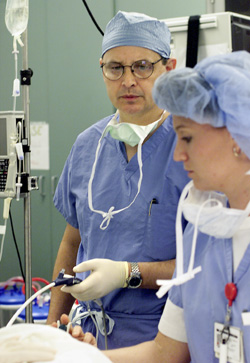
Dr. William Richards performs the Stretta procedure on patient Thelma Kirchdoerffer to treat GERD. Kelly McDaniel, RN, assists. (photo by Dana Johnson)
Stretta catheter offers outpatient heartburn relief

The Stretta procedure, used to treat GERD, was performed on patient Thelma Kirchdoerffer. (photo by Dana Johnson)
Lynn Ashby wrestled the symptoms of GERD, gastroesophageal reflux disease, for a dozen years before a brief TV newscast and an Internet search led her from her Huntsville, Ala., living room to Vanderbilt University Medical Center’s heartburn clinic, where doctors ended her bout with the disease.
Ashby suffered all the common symptoms of GERD — severe chest pain, a chronic cough and sore throat. She had to eat several small meals a day and couldn’t bend over without tasting acid reflux from the food she had just eaten — and she never had the satisfaction of feeling full after a meal.
But a new catheter called Stretta provided the first real relief for Ashby. “It’s the most wonderful thing that’s ever happened. I feel better than I have in years,” she says.
The device, manufactured by Curon Medical, was approved by the FDA in April. On Aug. 18, Vanderbilt Hospital became the first site in the Southeastern U.S. to employ Stretta when Dr. William Richards, professor of surgery, used it for Ashby’s GERD. Since then three other patients received the Stretta treatment and others are lined up.
GERD most often results when the lower esophageal sphincter, or LES, relaxes. The disease affects 14 million people in the U.S., according to Curon Medical. About 80 percent of those people are candidates for the Stretta procedure, Richards says. Someone with a large hiatal hernia would not be chosen for Stretta.
The standard treatment for repairing the LES is a laparoscopic technique called Nissen fundoplication, in which the upper stomach is wrapped around the esophagus in order to tighten the junction between the two.
While that procedure is still the gold standard, Richards says Stretta offers an outpatient fix with much less patient trauma, good outcomes and less expense. It went through trials at 14 U.S. medical centers with 130 patients.
The Stretta catheter is inserted through the patient’s mouth and a balloon is positioned along the gastroesophageal junction. The balloon is inflated at the catheter’s handle and four needles are deployed, sending radiofrequency energy into the tissue. The heat from the needles destroys nerves that play a part in reflux and they cause a buildup of scar tissue that tightens the gastroesophageal junction. Constant monitoring of the temperature ensures that surrounding tissue isn’t damaged.
“The studies have been quite amazing,” Richards says. “They’ve done a great job to engineer the catheter to heat up just enough to cause shrinking and tightening but not stricture.”
The technology, he says, is similar to the use of catheters threaded through the arteries into the heart to deliver electrosurgical energy that ablates heart nerves that cause certain arrythmias.
After treatment with Stretta, 87 percent of patients were able to discontinue use of proton pump inhibitors, the most potent medicine prescribed; 70 percent were able to discontinue use of all medication, including antacids; and there was a significant reduction in acid exposure in the esophagus.
“This is an in-between choice for patients with GERD,” says Dr. Glenn Eisen, associate professor of medicine and director of endoscopy who, with Dr. Chris Lind and Dr. Michael Holzman treats patients with difficult severe heartburn and GERD in the Vanderbilt gastroenterology clinic.
“We want to offer a wide array of services. This is for people who dislike taking medications, their medication is not working or those who don’t like the (laparoscopic) surgical option.”
Ashby was on daily medication for several years when the FDA removed from the shelves the one drug that was working best, Propulcid. But even with medical treatment, she says, she was still hoarse, coughed and had chest pain.
Now Ashby is off of all medication. “I never even filled the prescription for pain medication” after the procedure, she says.
Stretta also has an edge on cost. The laparoscopic procedure costs around $7,500-$10,000, while Stretta costs about the same as a year’s worth of medical therapy, between $2,000 and $3,000, Richards says.
When Ashby’s insurance company balked at Stretta, denying payment because they consider it experimental, she paid for the procedure herself.
One unknown element about Stretta, as it is with any new procedure, is the duration of the positive outcomes.
Richards says there’s no reason to believe the fix will not be permanent because the nerves are killed.
Ashby says even if the improvement is temporary, it’s been worth it. “I know I don’t have any guarantee of how long it will last, but it’s so benign as far as the (negative) impact to the patient,” she says. “I consider it worth doing, just for the improved quality of life. I sleep better now, and I feel better in general.”
For more information, call the Heartburn Clinic, 322-4880. Patients are seen on Tuesdays 1-4 p.m. and Thursdays 8:30a.m. – noon.













